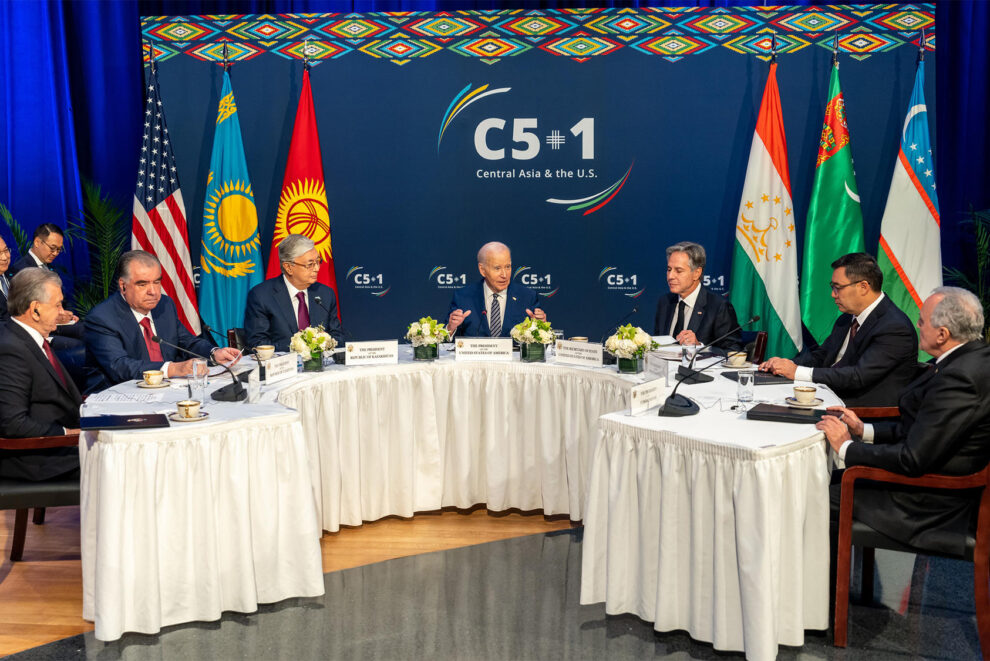Iran holds a pivotal role in bridging the geographically closed Central Asian region with the Middle East, South Asia, and the Caucasus, as well as Europe. As Uzbekistan’s economic growth intensifies, broadening its reach to export markets is necessary. As the country diversifies its trade routes, there has been a particular emphasis on the southern direction via Iran. After a long pause, Tashkent restarted political dialogue with Tehran in 2017, with a specific focus on the transport and transit aspects of bilateral engagement. This strategic alignment is deliberate, as Iran’s close proximity and harbors ensure swift access for Uzbek cargo to the Indian Ocean.
Southern Transit Direction
Central Asian states have been using the Iranian port of Bandar Abbas for years to enter world markets. Notably, the port serves as the central hub for the Uzbekistan-Turkmenistan-Iran-Oman multimodal route, initiated in 2011. The project was the first attempt to link Central Asia with the affluent Gulf monarchies through railways and ports. However, subsequent sanctions imposed on Iran impeded the project’s complete realization.
The Ashgabat Agreement, on the basis of which the transport corridor to Oman was launched, was reactivated only in 2022 through the collaborative endeavors of the Uzbek-Turkmen working group on transport communications. The bond between the two neighbors on this issue has played a pivotal role in reigniting interest in Iranian transit within the Central Asian region. Presently, there is an emerging informal trilateral between Tashkent, Ashgabat, and Tehran, which has consistently achieved success in executing promising transport initiatives.
Interest in Chabahar
In the fall of 2022, reports emerged regarding the development of a new logistics route spanning Uzbekistan-Turkmenistan-Iran-India, leveraging the deep-water port at Chabahar that opens into the vast expanse of the Indian Ocean. Managed by India, Chabahar port has undergone substantial modernization efforts, with significant investments made in its enhancement. Unlike Bandar Abbas, the Chabahar port operates outside the confines of the existing international sanctions regime, which can be seen as an additional advantage.
Last year, Uzbekistan received the right to jointly use the Chabahar port. Uzbekistan plans to build a sea terminal designed to facilitate the efficient handling, processing, and distribution of diverse cargo types. The creation of a logistics center with proper infrastructure was also announced. Investments in Chabahar will give impetus to the intensification of Uzbekistan’s trade with both Iran and other countries, including India, a substantial market.
Obviously, the possibilities of Iranian-Turkmen transit for Uzbekistan go far beyond the basic facilitation of swift and economical cargo movement solely within these nations. Tashkent is strategically leveraging this valuable asset to establish additional routes in collaboration with Ashgabat and Tehran, emphasizing the adaptability of the Uzbekistan-Turkmenistan-Iran transport corridor to factor in new participants. One interested party in such an expansion is Turkey, another important political and economic partner of Uzbekistan.
Reach the Borders of Europe
The railway route Turkey-Iran-Turkmenistan-Uzbekistan, with a length of over 4,500 kilometers, was launched in 2022. The freight train consisting of 40 wagons periodically runs between Izmir and Tashkent, creating an alternative to Trans-Caspian transportation. The monomodality of this new corridor reduces the time and financial costs for transporting goods, which increases its profitability and provides the way for further development.
The quartet soon breathed new life into the project, integrating it into an international multimodal route between Asia-Pacific countries and Europe. A corresponding protocol was signed at the 12th meeting of transport ministers of the Economic Cooperation Organization (ECO) on November 2, 2023 in Tashkent. The parties noted that the Uzbekistan-Turkmenistan-Iran-Turkey transport corridor will ensure reliable transit of goods from East Asia, notably China, toward Europe.
Given the significant trade balance between the European Union and China, as well as the latter’s interest in increasing the volume of land transport through Central Asia, the potential of the new corridor is anything but trivial. To capitalize on this opportunity, the beneficiary countries are working to eliminate legal and physical barriers in the field of mutual cargo transportation. The task has been set to switch to a unified tariff framework and digitalize transport services.
The Neighbors Are Not Asleep
Kazakhstan also seeks to contribute to connecting the Asia-Pacific region with Europe through Iran. Astana plays a key role in the development of the Trans-Caspian International Transport Route (TITR), also known as the Middle Corridor, which is currently heavily congested due to the closure of almost all EU border crossings with Russia and Belarus, impeding trade along the Northern Route.
However, infrastructural and administrative hurdles persist within the TITR, necessitating substantial investments and time for resolution. In order to maintain its transit attractiveness, Kazakhstan is quickly integrating into alternative logistics chains.
In October 2023, a virtual meeting was held between the transport ministers of Uzbekistan, Kazakhstan, Turkmenistan, Iran, and Turkey which discussed an agreement to establish an international transport corridor running from China to Kazakhstan, Uzbekistan, Turkmenistan, Iran, Turkey, and on to Europe.
A new route from China to Iran through Turkmenistan, excluding Uzbekistan, is nearing fruition following an agreement reached during the inaugural meeting of the Kazakh-Turkmen specialized working group in November 2023. Notably, freight trains operate between Iran, Turkmenistan, and Kazakhstan. Thanks to the railway, delivery of goods from China to the Iranian border takes only 12-14 days, currently representing the most optimal option.
Following their regional neighbors, Kyrgyzstan and Tajikistan began to seriously consider the possibilities of Iranian transit too. In October 2022, the Tajik side offered its services to organize road transport from China to Turkey, connecting through Uzbekistan, Turkmenistan, and Iran. This is how a new multimodal corridor, Tajikistan-Uzbekistan-Turkmenistan-Iran-Turkey (TUTIT), arose.
Kyrgyzstan is finding its strengths in trans-Iranian communications too. Within the Southern Transport Corridor, the Iran-Turkmenistan-Uzbekistan-Kyrgyzstan route operates. The railway line extends from the port of Bandar Abbas to the city of Osh. Over the course of nine months in 2023, more than 33,000 tons of cargo were transported in this direction. The parties are considering test launching a container train between Iran and Kyrgyzstan. In the meantime, Bishkek hopes to reach the borders of Turkey via Iranian roads. For this purpose, a Kyrgyzstan-Uzbekistan-Turkmenistan-Iran-Turkey multimodal corridor is being formed.
The rich variety of trade routes leading to and from Central Asia fully meets Tehran’s wide-ranging geoeconomic interests. Iran needs to have reliable and flexible transport communications with China and Russia, which are among its key trading partners. Here, Uzbekistan’s position is not as strong as that of Kazakhstan and Turkmenistan; however, the construction of the China-Kyrgyzstan-Uzbekistan railway will allow Tashkent to change the situation and become a central country in the transit of Iranian export products to East Asia.
The robust development of Uzbek-Iranian transport relations is catalyzing economic growth in Central Asia. This is reflected in growing volumes of interregional cargo traffic with all the associated benefits. Cargo transportation between Tashkent and Tehran has more than doubled in recent years, which sets a solid foundation for enduring collaboration among Central Asian nations.











